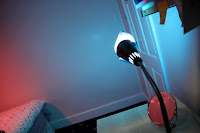Project Evaluation
In researching Maya Angelou I was inspired by her hard work with the civil rights movement and wanted to try and reflect this through my own film by making it about a social issue that was accessible to me. Hoping to also reflect the idea of bravery and overcoming fears from the original poem I decided to show somebody overcoming their dysphoria and changing into 'women's clothing'. Considering my late start to this project I’m
very happy with the final film I have produced. My film is a shortened version
of my original idea, cutting out the narrative and focusing on what I consider
to be the core of the idea – I think this was very beneficial overall, helping
to avoid distracting from main focus of the film.
However, with time I would have liked to deeper explore experimental methods of film-making during my research process. With the very stylistic look of my piece because of the bold lighting I think that some non-conventional editing or camera techniques could have added another level to the piece - adding more abstract ideals to reflect the compatibility the protagonist feels with gender binary.
However, with time I would have liked to deeper explore experimental methods of film-making during my research process. With the very stylistic look of my piece because of the bold lighting I think that some non-conventional editing or camera techniques could have added another level to the piece - adding more abstract ideals to reflect the compatibility the protagonist feels with gender binary.
In future I will try to pay more attention to understanding the contextual importance of my source material, as I feel this is something that lacked with my current piece. I was able to get an understanding of the piece and it's author but I feel I could have better tried to ascertain the context in which the poem was written and tried to reflect it's relevance through my own production.
I was very happy with the results from our lighting workshop which inspired the bold lighting in my final film. Whilst experimenting with different coloured gels we found that when mixing gels on different lights the colour of shadows could be manipulated. I realised that this was an affective way to reflect the idea of gender binary - using blue lights when the character wears 'male clothes' and pink when they're conforming to traditionally female rules. This ended up as an essential aspect of the film and has been complimented by peers that saw the rough cut and our tutor, Sam.
During shooting I realised that I had neglected to consider getting a make-up artist to ensure Jack's final look was more polished. However, upon reflection I think that Jack's inexperience reflects somebody starting to explore their gender identity.
Despite this, if I made the film again I would have liked to pre-plan the outfit as the one from the final film didn't reflect the look I wanted to. This wasn't something I was able to consider during this production due to my limited time and budget; instead the outfit was a combination of clothes that I and my actor had, hoping to keep to the core idea of the film and find something that Jack was comfortable in.
Despite this, if I made the film again I would have liked to pre-plan the outfit as the one from the final film didn't reflect the look I wanted to. This wasn't something I was able to consider during this production due to my limited time and budget; instead the outfit was a combination of clothes that I and my actor had, hoping to keep to the core idea of the film and find something that Jack was comfortable in.
The feedback I got to my rough cut was incredibly useful, helping reassure a few worries I had about the piece as it was and also in pinpointing a few extra issues to be fixed. Our tutor told me watch out as the film was beginning to border on something that could seem erotic - to avoid this I cut some clips and added in some extreme close-ups - acquired from re-shoots - hoping to re-focus the film. Sam also noted that the pacing at the beginning of the film was quite slow and implied an unnecessary anxiety to the character. This was a simple fix done by cutting down the lengths of some earlier shots.























